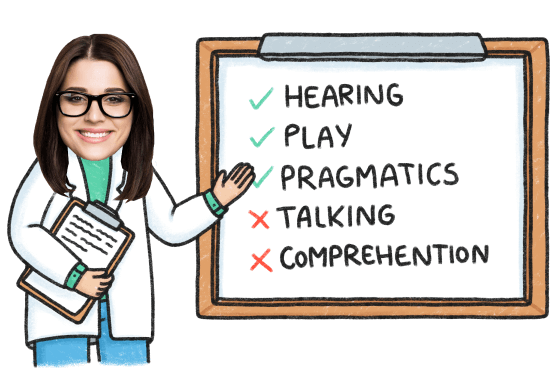Common Techniques Used by Speech Therapists
May 30, 2024 During therapy sessions, speech therapists can use a variety of strategies to help a child’s communication skills.
In this reading, you will get to see some of the common techniques used by speech therapists and hopefully, you can use some of them when practicing with your little tots.
In This Article
Boost Your Child’s Speech Development!
Improve language & communication skills with fun learning!

Speech Therapy Techniques You Can Do at Home
Watch the video below to learn more about how to practice speech therapy at home.
Give Choices
Do you want to play with the blocks or Play-doh?
Giving your child a choice will not only keep them motivated but doing so can also encourage their language development and decision-making.
Self-talk
Self-talk is a technique where speech therapists talk about what they are doing, what they see, feel or hear. For example, during a session, a speech pathologist will narrate how she’s going to get flashcards out of the drawer . . . or how she’s going to build a tower out of Legos, etc.
Parallel Talk
Parallel talk is mainly the speech pathologist describing what the child is doing, feeling, or hearing. (Ohhh you are playing with your toys . . . You are eating your peas.)
Modeling
If your child is working on a specific sound or word, don’t simply tell them to say it; model the word you want them to work on, then have them repeat after you.
And of course, talk slowly
When working on a child’s communication skills, talk at a slow pace for them to understand and repeat.
Expansion
It’s about adding one or more words whenever your child talks to model to correct sentence structure. If they point to a doll and say “That doll tall,” say: “Oh yes, that doll is tall.”
Simplify Sentences
You can expand a child’s sentence structure while keeping it short, clear, and concise. Remember, simplicity is key. Instead of saying “Sarah enjoys making the creamiest and the most flavorful cupcakes,” you can say “Sara loves making cupcakes.”
Asking Open-ended Questions
Instead of asking closed-ended questions, ask open-ended questions to lead to more communication. Instead of saying “is this blue?” Ask “what color is the bowl?”
Sabotage
Use this method while playing with your little one or incorporate it in your daily routines. For instance, if it’s time to eat breakfast, give your toddler cereal and milk with a fork. Then, wait for them to ask for the spoon.
Visuals
Having your child repeat words is great, but showing pictures along the words will probably motivate them more, while also improving their brain’s development.
Withholding
Sometimes speech therapists will withhold a child’s favorite toy or object as a way of getting them to use their words and make requests. If they point at the object they want, model the word for them to repeat. (“Do you want the ball? Can you say more ball please?”)
Wait Time
Whether you ask your child a question or ask them to repeat a word, give them a few seconds to respond.
Use Silly Words and Sentences
You may be wondering whether silly sentences are something productive. But the truth is, speech therapists will at times use silly phrases to further stimulate a child’s articulation skills. (“My little spider went to London to buy leather.”).
Following a Child’s Lead
Following your toddler’s lead is more about observing and noticing what they like to play with, then using their interest to get them to communicate and work on their speech.
Positive Reinforcement
While it is always great to praise a child’s effort for saying a word or sentence correctly, it is also good to praise their attempt as a way of building their confidence and encouraging them to practice more.
Repetition
I’ll say it a million times, repetition is a great method for kids to practice their speech and language skills. If they repeat the words or sentences making an error (“I love wabbits“) model the phrase correctly for them to repeat again (“You love rabbits . . . say rabbit etc.”)
Sign Language
Because it can aid a child’s developmental verbal language, speech therapists will sometimes incorporate sign language during their sessions to help a child better communicate.
Singing
I could be biased myself because I love to do it, but singing with your child is not only fun, but it teaches them about rhymes while also expanding their vocabulary skills. So don’t be afraid to try it.
When in Doubt, Find an SLP!
If you find yourself wondering if you should contact a speech-language pathologist, then you probably should. Their speech therapy techniques are sure to help. The “wait-and-see” approach can just put your child behind his peers.
If you still aren’t sure, download Speech Blubs and fill out our evaluative screener. It was made with the help of speech therapists and gives a pretty good idea about your child’s speech status. While it’s no substitute for pediatric speech therapy, our app can get you started and gives plenty of focused speech practice. So start now!
Check out the resources for this article.

